Sustainable Viticulture on Traditional ‘Baran’ Training System in Eastern Turkey
Abstract
1. Introduction
2. Materials and Methods
2.1. Plant Material, Sampling and Location
2.2. Traditional ‘Baran’ Training System
2.3. Morphological Traits
2.4. Biochemical Traits
2.4.1. Specific Sugars
2.4.2. Organic Acids
2.5. Sensory Evaluation
2.6. Statistical Analysis
3. Results and Discussion
3.1. Yield, Marketable Product and Morphological Traits
3.2. Sugar Content
3.3. Organic Acid Content
3.4. Sensory Evaluation
4. Conclusions
Author Contributions
Funding
Institutional Review Board Statement
Informed Consent Statement
Data Availability Statement
Conflicts of Interest
References
- Kandemir, A. Endemic plants of Erzincan and threatening. In Proceedings of the Biological Diversity Symposium, Ankara, Turkey, 22–23 May 2012; pp. 108–109. [Google Scholar]
- Davis, P.H. (Ed.) 1965–1985. Flora of Turkey and the East Aegean Islands; Edinburgh Univ. Press: Edinburgh, UK, 2000; Volume 1–9. [Google Scholar]
- Korkmaz, M.; Ozcelik, H.; Kandemir, A.; Ilhan, V. Natural rose (Rosa L.) taxa distributed in Erzincan and its Envrons. Suleyman Demirel Univ. J. Nat. Appl. Sci. 2013, 17, 49–59. [Google Scholar]
- Ozhatay, N. Important Plant Areas around BTC Pipeline; BTC Company: Istanbul, Turkey, 2006; pp. 125–127. [Google Scholar]
- Akpinar, E.; Celikoglu, S. The contribution of Cimin (black plum) grape to the economy and publicity of Erzincan. In Proceedings of the International Erzincan Symposium, Erzincan, Turkey, 28 September–1 October 2016; Volume 2, pp. 16–23. [Google Scholar]
- Kupe, M. Determining Suitable Pruning Level after Winter Frost Damage in Karaerik Grape Cultivar Grown in Uzumlu District of Erzincan. Master’s Thesis, Ataturk University Institute of Science, Erzurum, Turkey, 2013; 75p. [Google Scholar]
- FAO. Food and Agriculture Organization of the United Nations. 2020. Available online: http://www.fao.org/faostat/en/#data/QC (accessed on 12 June 2021).
- Çelik, H.; Köse, B.; Cangi, R. Determination of Fox grape genotypes (Vitis labrusca L.) grown in Northeastern Anatolia. Hort. Sci. 2008, 35, 162–170. [Google Scholar]
- Soylemezoglu, G.; Atak, A.; Boz, Y.; Unal, A.; Saglam, M. Viticulture in Turkey. Chronica Hortic. 2016, 56, 27–31. [Google Scholar]
- Isci, B.; Kacar, E.; Altındisli, A. The effects of some exogenous applications on quality in ‘Crimson Seedless’ grape. Erwerbs-Obstbau 2020, 62, 87–100. [Google Scholar] [CrossRef]
- Kara, Z.; Yazar, K.; Doğan, O.; Vergili, E. Sodium nitroprusside and gibberellin effects on seed germination and seedling development of grapevine (Vitis vinifera L.) cvs. Ekşi Kara and Gök Üzüm. Erwerbs-Obstbau 2020, 62, 61–68. [Google Scholar] [CrossRef]
- Tangolar, S.; Tangolar, S.; Turan, M.; Ateş, F. Determination of phytochemical and mineral contents of seeds from ‘Semillon’and ‘Carignane’ wine grape cultivars grown under different irrigation conditions. Erwerbs-Obstbau 2020, 62, 115–123. [Google Scholar] [CrossRef]
- Melgarejo, P.; Salazar, D.M.; Artes, F. Organic acids and sugars composition of harvested pomegranate fruits. Eur. Food Res. Technol. 2000, 211, 185–190. [Google Scholar] [CrossRef]
- Bevilacqua, A.E.; Califano, A.N. Determination of organic acids in dairy products by high performance liquid chromatography. J. Food Sci. 1989, 54, 1076–1079. [Google Scholar] [CrossRef]
- Chouksey, S.; Singh, A.; Thakur, R.S.; Deshmukh, R. Influence of gamma irradiation and benzyl adenine on keeping quality of custard apple fruits during storage. J. Food Sci. Technol. 2013, 50, 934–941. [Google Scholar] [CrossRef][Green Version]
- Cangi, R.; Kesgin, M.; Yagci, A. An economic analysis of shading and covering material applications on table grape growing of sultani seedless cultivar. J. Agric. Fac. Gaziosmanpaşa Univ. 2011, 28, 9–19. [Google Scholar]
- Ates, F.; Uysal, H. Determinations of adaptation level of wine grape varieties in terms of climatic data in wine growing regions of turkey. BIO Web Conf. 2017, 9, 01027. [Google Scholar] [CrossRef]
- TURKSTAT. Turkish Statistical Institute Online Statistical Database: Turkish Statistical Institute. 2019. Available online: https://biruni.tuik.gov.tr (accessed on 10 October 2020).
- Gazioglu Sensoy, R.I.; Balta, F. Adaptation of some grape cultivars to Van ecological condition. YYU J. Agric. Sci. 2010, 20, 159–170. [Google Scholar]
- OIV. Organisation Internationale de la Vigne et du Vin. In OIV Descriptor List for Grape Varieties and Vitis Species, 2nd ed.; Organization Intergouvernementale crée par l’Accord International: Paris, France, 2001; Available online: https://www.oiv.int/public/medias/2274/code-2e-edition-finale.pdf (accessed on 20 June 2021).
- Kök, D.; Bal, E.; Bahar, E. Physical and biochemical traits of selected grape varieties cultivated in Tekirdağ, Turkey. Int. J. Sustain. Agric. Manag. Inform. 2017, 3, 215–223. [Google Scholar] [CrossRef]
- Dilli, Y.; Kader, S. 2020; Table, Wine and Dried Grape Cultivars. Available online: https://arastirma.tarimorman.gov.tr/manisabagcilik/Belgeler/genelbagcilik/UZUM%20CESITLERI%20YILDIZ%20DILLI.pdf (accessed on 25 June 2021).
- Winkler, A.J.; Cook, J.A.; Kliewer, W.M.; Lider, L.A. General Viticulture, 2nd ed.; University of California Press: Berkeley, CA, USA, 1974; 710p. [Google Scholar]
- Dardeniz, A. Effects of cluster tipping on yield and quality of Uslu and Cardinal table grape cultivars. COMU J. Agric. Fac. 2014, 2, 21–26. [Google Scholar]
- Eyduran, S.P.; Akin, M.; Ercisli, S.; Eyduran, E.; Maghradze, D. Sugars, organic acids, and phenolic compounds of ancient grape cultivars (Vitis vinifera L.) from lgdir province of Eastern Turkey. Biol. Res. 2015, 48, 2. [Google Scholar] [CrossRef] [PubMed]
- Petrisor, C.; Chirecanu, C. Organic acids and sugars profile of some grape cultivars affected by grapevine yellows symptoms. Rom. Biotechnol. Lett. 2019, 24, 1027–1033. [Google Scholar] [CrossRef]
- Zhang, D.; Zhang, Y.; Lin, K.; Wang, B.; Shi, X.; Cheng, W. Comparison of sugars, organic acids and aroma components of five table grapes in Xinjiang. IOP Conf. Ser. Earth Environ. Sci. 2021, 792, 012029. [Google Scholar] [CrossRef]
- Korkutal, I.; Bahar, E.; Ozge, K. The effect of altitude on grape quality. Trakya Univ. Eng. Sci. J. 2012, 13, 17–29. [Google Scholar]
- Frioni, T.; Squeri, C.; Del Zozzo, F.; Guadagna, P.; Gatti, M.; Vercesi, A.; Poni, S. Investigating evolution and balance of grape sugars and organic acids in some new pathogen-resistant white grapevine varieties. Horticulturae 2021, 7, 229. [Google Scholar] [CrossRef]
- Sensoy Gazioglu, R.I. Determination of organic acids, sugars, and macro-micro nutrient contents of must in some grape (Vitis vinifera L.) cultivars. J. Anim. Plant Sci. 2015, 25, 693–697. [Google Scholar]
- Meng, J.-F.; Xu, T.-F.; Song, C.-Z.; Yu, Y.; Hu, F.; Zhang, L.; Zhang, Z.-W.; Xi, Z.-M. Melatonin treatment of pre-veraison grape berries to increase size and synchronicity of berries and modify wine aroma components. Food Chem. 2015, 185, 127–134. [Google Scholar] [CrossRef]
- Davies, C. Sugar accumulation in grape berries. Cloning of two putative vacuolar invertase cDNAs and their expression in grapevine tissues. Plant Physiol. 1996, 111, 275–283. [Google Scholar] [CrossRef]
- Xie, Z.; Li, B.; Forney, C.F.; Xu, W.; Wang, S. Changes in sugar content and relative enzyme activity in grape berry in response to root restriction. Sci. Hortic. 2009, 123, 39–45. [Google Scholar] [CrossRef]
- Zheng, L.; Nie, J.; Yan, Z. Advances in research on sugars, organic acids and their effects on taste of fruits. J. Fruit Sci. 2015, 32, 304–312. [Google Scholar]
- Liu, F.; Wu, B.-H.; Fan, P.-G.; Li, S.-H.; Li, L.-S. Sugar and acid concentrations in 98 grape cultivars analyzed by principal component analysis. J. Sci. Food Agric. 2006, 86, 1526–1536. [Google Scholar] [CrossRef]
- Piazzolla, F.; Pati, S.; Amodio, M.; Colelli, G. Effect of harvest time on table grape quality during on-vine storage. J. Sci. Food Agric. 2016, 96, 131–139. [Google Scholar] [CrossRef]
- Coelho, E.M.; Padilha, C.V.S.; Miskinis, G.A.; de Sa, A.G.B.; Pereira, G.E.; Azavedo, L.C.; Lima, M.S. Simultaneous analysis of sugars and organic acids in wine and grape juices by HPLC: Method validation and characterization of products from northeast Brazil. J. Food Comp. Anal. 2018, 66, 160–167. [Google Scholar] [CrossRef]
- Jediyi, H.; Naamani, K.; Elkoch, A.A.; Dihazi, A.; El Fels, E.A.; Arkize, W. First study on technological maturity and phenols composition during the ripeness of five Vitis vinifera L. grape varieties in Morocco. Sci. Hortic. 2019, 246, 390–397. [Google Scholar] [CrossRef]
- Gokturk-Baydar, N. Organic acid, tocopherol and phenolic compositions of some Turkish grape cultivars. Chem. Nat. Compd. 2006, 42, 56–59. [Google Scholar] [CrossRef]
- Webb, A.D. Quality factors in California grapes. In Quality of Selected Fruits and Vegetables of North America; Teranishi, R., Barrera-Benitez, H., Eds.; American Chemical Society: Washington, DC, USA, 1981; pp. 1–9. [Google Scholar]
- Zia-Ul-Haq, M.; Ahmad, S.; Qayum, M.; Ercisli, S. Compositional studies and antioxidant potential of Albizia lebbeck (L.) Benth. Pods and seeds. Turk. J. Biol. 2013, 37, 25–32. [Google Scholar]
- Bolat, I.; Dikilitas, M.; Ercisli, S.; Ikinci, A.; Tonkaz, T. The effect of water stress on some morphological, physiological, and biochemical characteristics and bud success on apple and quince rootstocks. Sci. World J. 2014, 2014, 1–8. [Google Scholar]
- Dogan, H.; Ercisli, S.; Jurikova, T.; Temim, E.; Leto, A.; Hadziabulic, A.; Tosun, M.; Narmanlioglu, H.K.; Zia-Ul-Haq, M. Physicochemical and antioxidant characteristics of fruits of cape gooseberry (Physalis peruviana L.) from Turkey. Oxid. Commun. 2014, 37, 1005–1014. [Google Scholar]
- Dogan, H.; Ercisli, S.; Temim, E.; Hadziabulic, A.; Tosun, M.; Yilmaz, S.O.; Zia-Ul-Haq, M. Diversity of chemical content and biological activity in flower buds of a wide number of wild grown caper (Capparis ovate Desf.) genotypes from Turkey. Comptes Rendus Acad. Bulg. Sci. 2014, 67, 1593–1600. [Google Scholar]
- Gundogdu, M.; Ozrenk, K.; Ercisli, S.; Kan, T.; Kodad, O.; Hegedus, A. Organic acids, sugars, vitamin C content and some pomological characteristics of eleven hawthorn species (Crataegus spp.) from Turkey. Biol. Res. 2014, 47, 21. [Google Scholar] [CrossRef]
- Candir, E.; Ozdemir, A.E.; Aksoy, M.C. Effects of modified atmosphere packaging on the storage and shelf life of Hicaznar pomegranate fruits. Turk. J. Agric. For. 2019, 43, 241–253. [Google Scholar] [CrossRef]
- Ozdemir, A.E.; Didin, O.; Candir, E.; Kaplankiran, M.; Yildiz, E. Effects of rootstocks on storage performance of Nova mandarins. Turk. J. Agric. For. 2019, 43, 307–317. [Google Scholar] [CrossRef]
- Ozkan, G. Phenolic compounds, organic acids, vitamin C and antioxidant capacity in Prunus spinose. Comptes Rendus Acad. Bulg. Sci. 2019, 72, 267–273. [Google Scholar]
- Bozhuyuk, M.R.; Ercisli, S.; Orhan, E.; Koc, A. Determination of the genetic diversity of walnut (Juglans regia L.) cultivar candidates from Northeastern Turkey using SSR markers. Mitt. Klost. 2020, 70, 269–277. [Google Scholar]
- Ozkan, G.; Ercisli, S.; Sagbas, H.I.; Ilhan, G. Diversity on fruits of wild grown European cranberrybush from Coruh valley in Turkey. Erwerbs-Obstbau 2020, 62, 275–279. [Google Scholar] [CrossRef]
- Abbott, J.A. Quality measurement of fruits and vegetables. Postharvest Biol. Technol. 1999, 15, 207–225. [Google Scholar] [CrossRef]
- Ma, C.; Fu, Z.; Xu, M.; Trebar, M.; Zhang, X. Evaluation on home storage performance of table grape based on sensory quality and consumers’ satisfaction. J. Food Sci. Technol. 2016, 53, 1363–1370. [Google Scholar] [CrossRef] [PubMed]
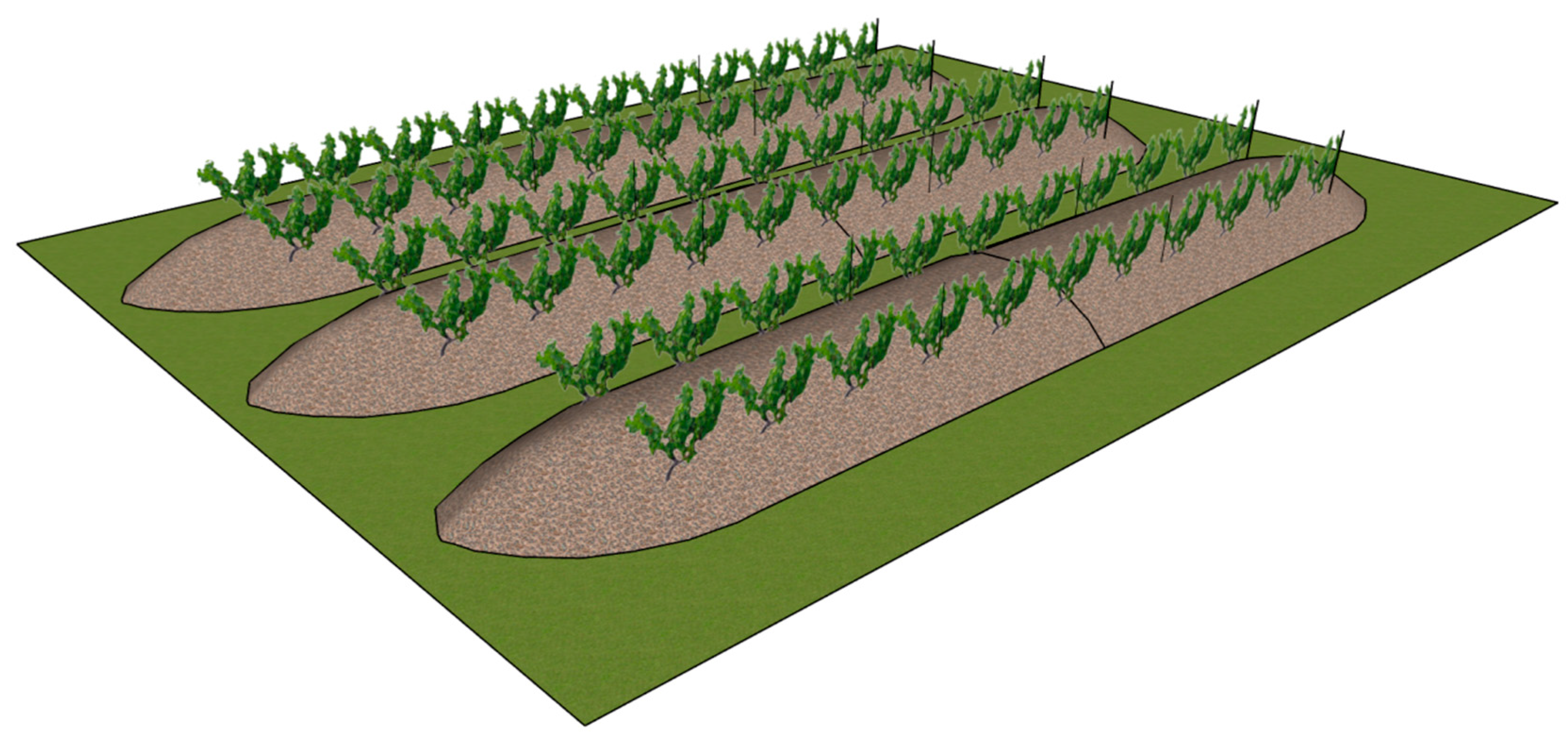
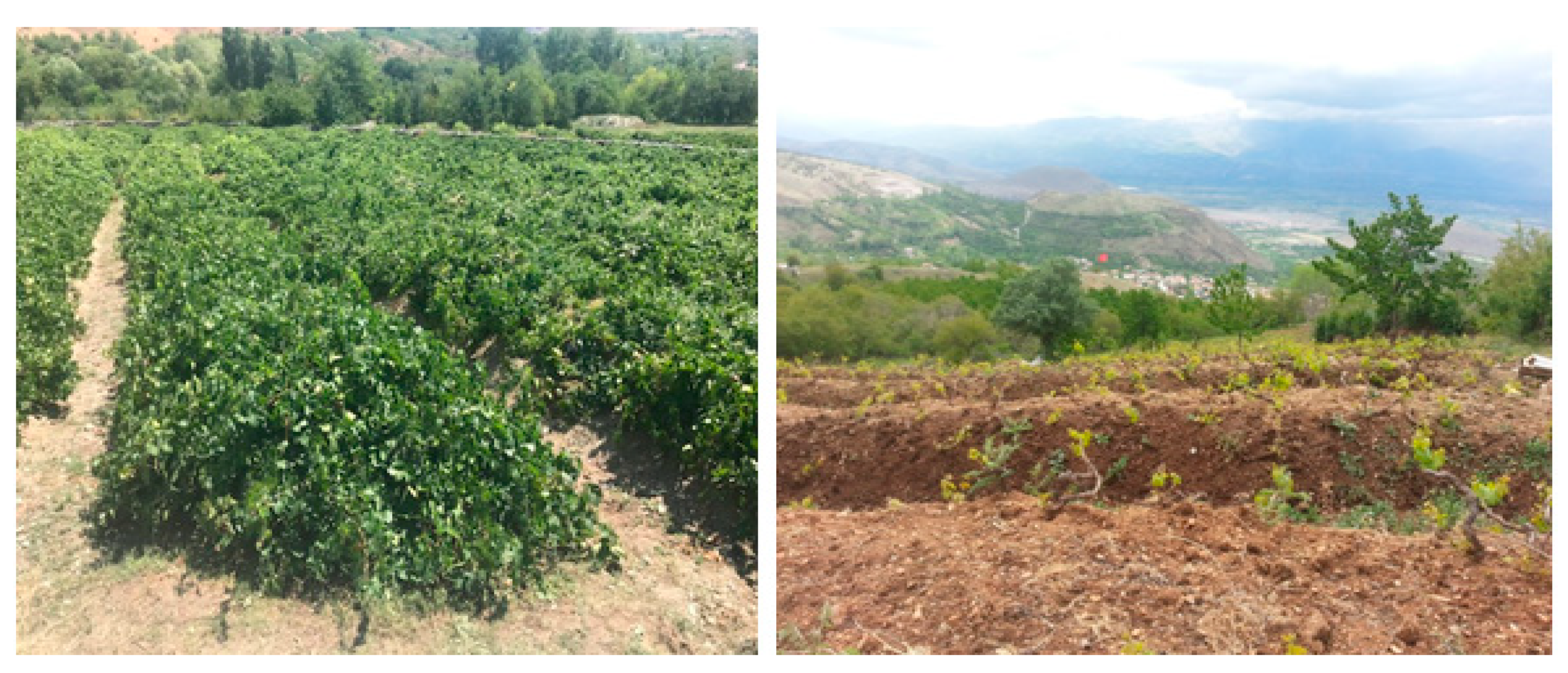
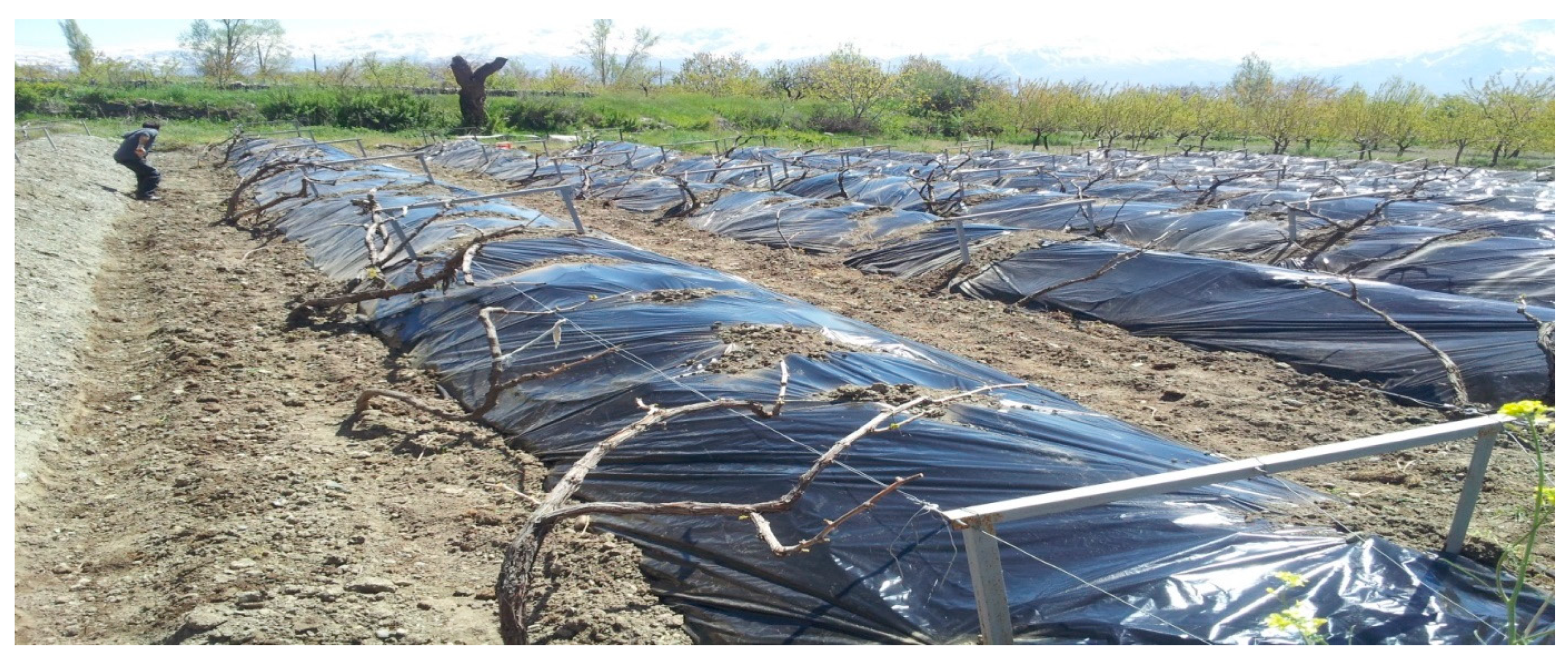
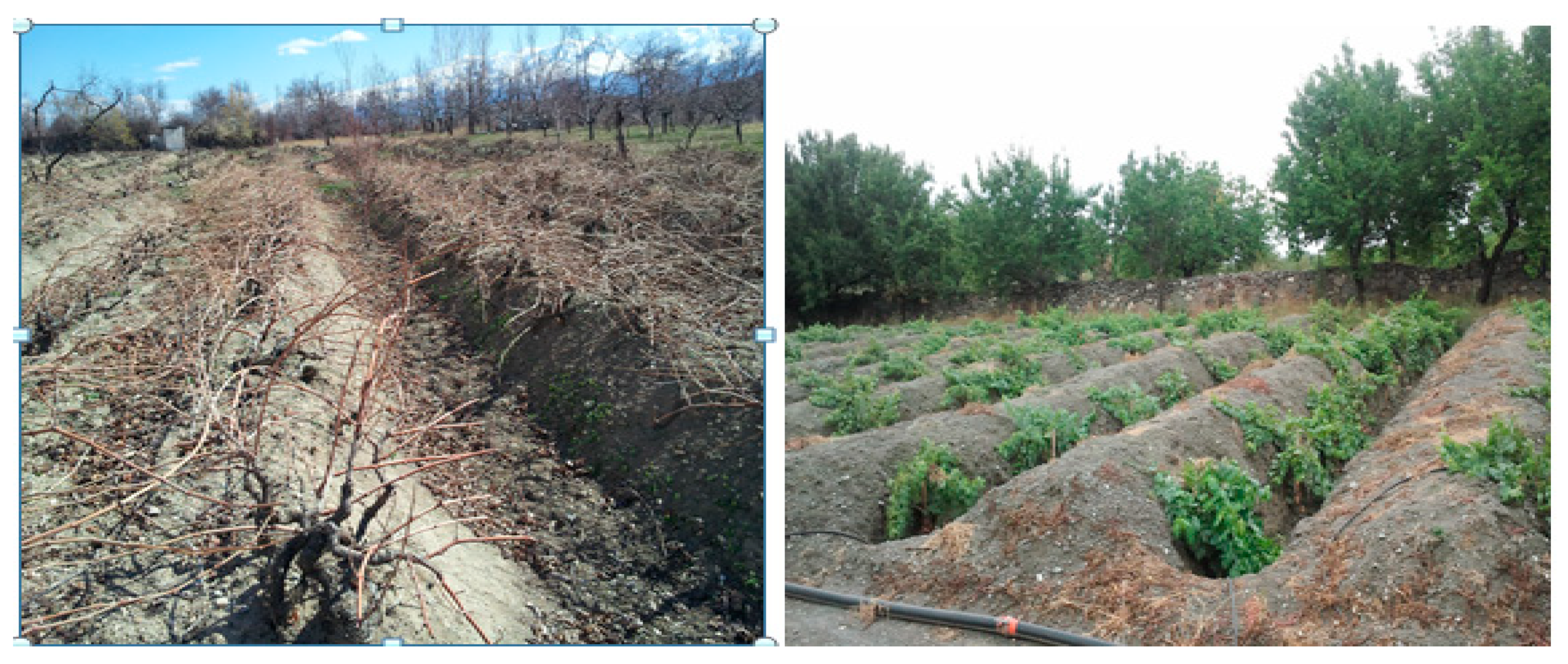
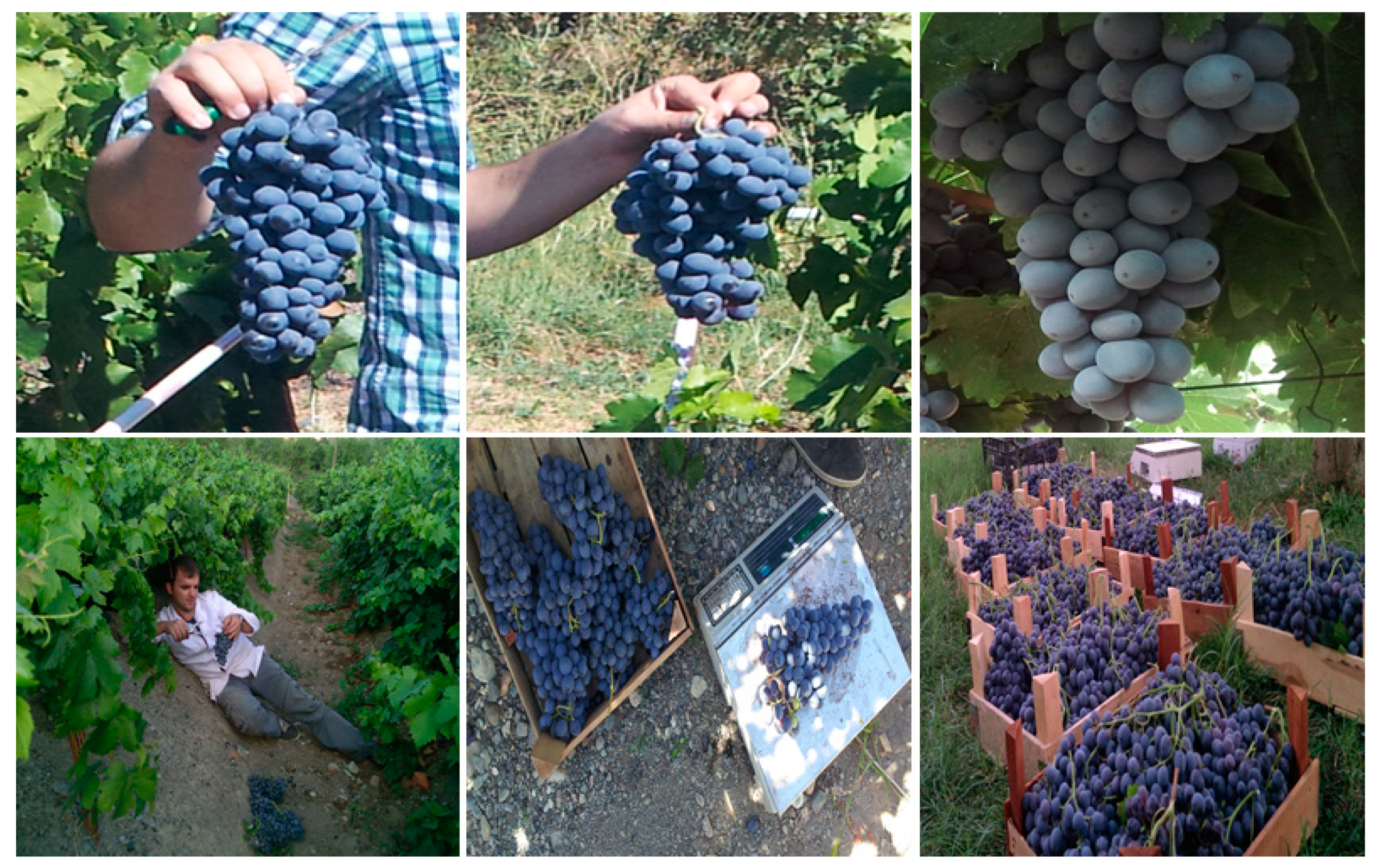
| Altitude | Yield (kg/Decare) | Marketable Product (%) | Harvest Period | Cluster Form | Cluster Weight (g) |
|---|---|---|---|---|---|
| 1200 m a.s.l. | 740a | 86.40a | Mid-season | Winged cylindrical | 478a |
| 1400 m a.s.l. | 682b | 79.12b | Mid-late season | Winged conical | 430b |
| 1600 m a.s.l. | 624c | 78.33b | Late season | Conical | 390c |
| Sample Altitude | Fructose | Glucose | Sucrose |
|---|---|---|---|
| 1200 m a.s.l. | 10.04c | 8.94c | 0.09 NS |
| 1400 m a.s.l. | 11.63b | 10.60b | 0.08 |
| 1600 m a.s.l. | 14.02a | 11.84a | 0.05 |
| Sample Altitude | Tartaric | Malic | Citric |
|---|---|---|---|
| 1200 m a.s.l. | 2.17c | 1.45c | 0.14 NS |
| 1400 m a.s.l. | 2.88b | 1.84b | 0.22 |
| 1600 m a.s.l. | 3.66a | 2.30a | 0.25 |
| Sample Altitude | Appearance (Color) | Cleanliness (Berry Bloom) | Taste | Texture |
|---|---|---|---|---|
| 1200 m a.s.l. | 8.60a | 8.20b | 8.00a | 7.60b |
| 1400 m a.s.l. | 8.20b | 8.00b | 7.60b | 8.00a |
| 1600 m a.s.l. | 7.80c | 8.60a | 7.60b | 8.00a |
Publisher’s Note: MDPI stays neutral with regard to jurisdictional claims in published maps and institutional affiliations. |
© 2021 by the authors. Licensee MDPI, Basel, Switzerland. This article is an open access article distributed under the terms and conditions of the Creative Commons Attribution (CC BY) license (https://creativecommons.org/licenses/by/4.0/).
Share and Cite
Kupe, M.; Ercisli, S.; Baron, M.; Sochor, J. Sustainable Viticulture on Traditional ‘Baran’ Training System in Eastern Turkey. Sustainability 2021, 13, 10236. https://doi.org/10.3390/su131810236
Kupe M, Ercisli S, Baron M, Sochor J. Sustainable Viticulture on Traditional ‘Baran’ Training System in Eastern Turkey. Sustainability. 2021; 13(18):10236. https://doi.org/10.3390/su131810236
Chicago/Turabian StyleKupe, Muhammed, Sezai Ercisli, Mojmir Baron, and Jiri Sochor. 2021. "Sustainable Viticulture on Traditional ‘Baran’ Training System in Eastern Turkey" Sustainability 13, no. 18: 10236. https://doi.org/10.3390/su131810236
APA StyleKupe, M., Ercisli, S., Baron, M., & Sochor, J. (2021). Sustainable Viticulture on Traditional ‘Baran’ Training System in Eastern Turkey. Sustainability, 13(18), 10236. https://doi.org/10.3390/su131810236








